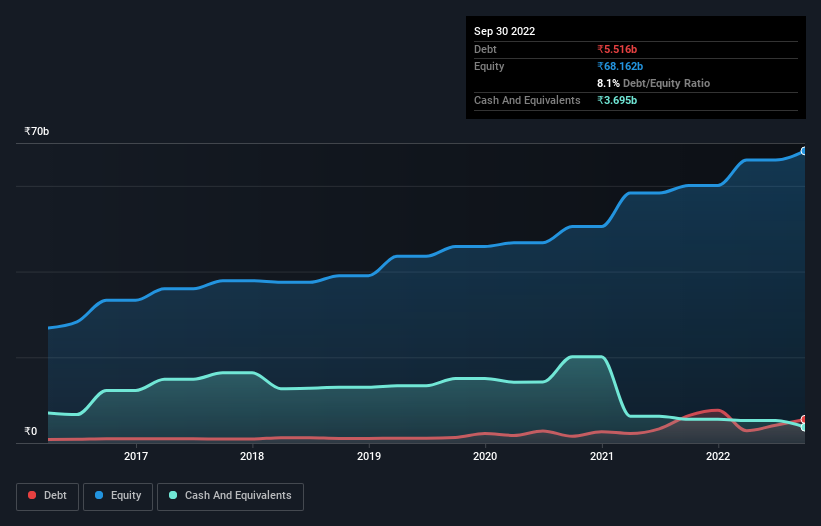We Think Pidilite Industries (NSE:PIDILITIND) Can Stay On Top Of Its Debt

The external fund manager backed by Berkshire Hathaway's Charlie Munger, Li Lu, makes no bones about it when he says 'The biggest investment risk is not the volatility of prices, but whether you will suffer a permanent loss of capital.' So it might be obvious that you need to consider debt, when you think about how risky any given stock is, because too much debt can sink a company. We can see that Pidilite Industries Limited (NSE:PIDILITIND) does use debt in its business. But is this debt a concern to shareholders?
What Risk Does Debt Bring?
Debt is a tool to help businesses grow, but if a business is incapable of paying off its lenders, then it exists at their mercy. Ultimately, if the company can't fulfill its legal obligations to repay debt, shareholders could walk away with nothing. While that is not too common, we often do see indebted companies permanently diluting shareholders because lenders force them to raise capital at a distressed price. By replacing dilution, though, debt can be an extremely good tool for businesses that need capital to invest in growth at high rates of return. The first step when considering a company's debt levels is to consider its cash and debt together.
See our latest analysis for Pidilite Industries
What Is Pidilite Industries's Debt?
You can click the graphic below for the historical numbers, but it shows that Pidilite Industries had ₹5.52b of debt in September 2022, down from ₹6.40b, one year before. However, because it has a cash reserve of ₹3.70b, its net debt is less, at about ₹1.82b.

A Look At Pidilite Industries' Liabilities
We can see from the most recent balance sheet that Pidilite Industries had liabilities of ₹26.1b falling due within a year, and liabilities of ₹5.72b due beyond that. Offsetting these obligations, it had cash of ₹3.70b as well as receivables valued at ₹16.7b due within 12 months. So its liabilities total ₹11.4b more than the combination of its cash and short-term receivables.
Having regard to Pidilite Industries' size, it seems that its liquid assets are well balanced with its total liabilities. So it's very unlikely that the ₹1.27t company is short on cash, but still worth keeping an eye on the balance sheet. Carrying virtually no net debt, Pidilite Industries has a very light debt load indeed.
In order to size up a company's debt relative to its earnings, we calculate its net debt divided by its earnings before interest, tax, depreciation, and amortization (EBITDA) and its earnings before interest and tax (EBIT) divided by its interest expense (its interest cover). Thus we consider debt relative to earnings both with and without depreciation and amortization expenses.
With debt at a measly 0.093 times EBITDA and EBIT covering interest a whopping 50.3 times, it's clear that Pidilite Industries is not a desperate borrower. Indeed relative to its earnings its debt load seems light as a feather. Pidilite Industries's EBIT was pretty flat over the last year, but that shouldn't be an issue given the it doesn't have a lot of debt. There's no doubt that we learn most about debt from the balance sheet. But it is future earnings, more than anything, that will determine Pidilite Industries's ability to maintain a healthy balance sheet going forward. So if you want to see what the professionals think, you might find this free report on analyst profit forecasts to be interesting.
Finally, a business needs free cash flow to pay off debt; accounting profits just don't cut it. So the logical step is to look at the proportion of that EBIT that is matched by actual free cash flow. In the last three years, Pidilite Industries's free cash flow amounted to 42% of its EBIT, less than we'd expect. That weak cash conversion makes it more difficult to handle indebtedness.
Our View
Happily, Pidilite Industries's impressive interest cover implies it has the upper hand on its debt. And the good news does not stop there, as its net debt to EBITDA also supports that impression! When we consider the range of factors above, it looks like Pidilite Industries is pretty sensible with its use of debt. While that brings some risk, it can also enhance returns for shareholders. The balance sheet is clearly the area to focus on when you are analysing debt. However, not all investment risk resides within the balance sheet - far from it. For instance, we've identified 2 warning signs for Pidilite Industries that you should be aware of.
If, after all that, you're more interested in a fast growing company with a rock-solid balance sheet, then check out our list of net cash growth stocks without delay.
New: Manage All Your Stock Portfolios in One Place
We've created the ultimate portfolio companion for stock investors, and it's free.
• Connect an unlimited number of Portfolios and see your total in one currency
• Be alerted to new Warning Signs or Risks via email or mobile
• Track the Fair Value of your stocks
Have feedback on this article? Concerned about the content? Get in touch with us directly. Alternatively, email editorial-team (at) simplywallst.com.
This article by Simply Wall St is general in nature. We provide commentary based on historical data and analyst forecasts only using an unbiased methodology and our articles are not intended to be financial advice. It does not constitute a recommendation to buy or sell any stock, and does not take account of your objectives, or your financial situation. We aim to bring you long-term focused analysis driven by fundamental data. Note that our analysis may not factor in the latest price-sensitive company announcements or qualitative material. Simply Wall St has no position in any stocks mentioned.
About NSEI:PIDILITIND
Pidilite Industries
Engages in the manufacture and sale of consumer and specialty chemicals in India and internationally.
Outstanding track record with flawless balance sheet and pays a dividend.


